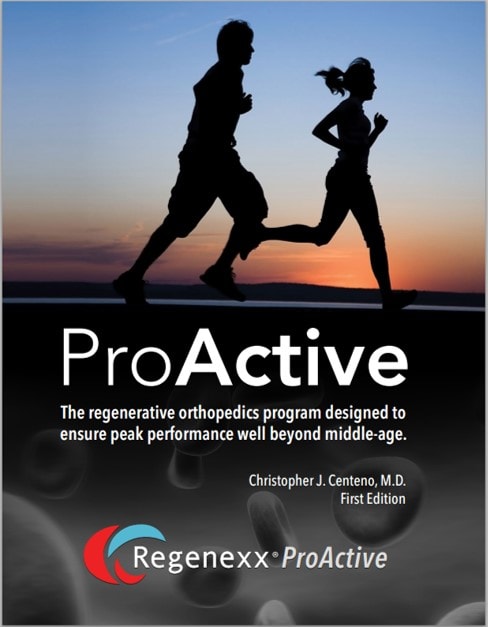My Recent ProActive Journey
We have a concept at Regenexx called ProActive. I just recently got a ProActive injections series, so let’s dive into the concept. What is it and what did I do?
What is ProActive?
ProActive is a Regenexx program where our physicians focus on treating small problems while they’re small before they become big issues that need more invasive solutions. It’s both a concept and a program. To learn more about the concepts, you can read a short book below (click on the book cover):
To learn more about the cost savings program that powers all of this, contact your local Regenexx provider.
My Small Problems
Many years ago I badly sprained my ankle and it didn’t heal. Since this was in the 90s, I didn’t know about orthobiologics, so I ended up buying many different types of ankle braces. However, eventually, I had my colleagues inject those ligaments with PRP and it got good enough that I didn’t need the braces anymore. However, a decade and a half later I can tell that through the wear and tear we all get, superimposed upon my injury, those ligaments are loose again.
My knee caps have very mild arthritis. Why? My low back has a chronically irritated S1 nerve as a result of a car crash in the late 80s. That nerve irritation reduces my hamstring and glut activity just enough to overwork my quads which puts too much stress and strain on my knee cap cartilage. My back also has some loose ligaments at L5-S1.
The Injection Strategy
The ProActive injection strategy is different than getting bigger injections. Meaning, the goal is smaller procedures that you can get “on the fly”. So as an example, I also needed work in my neck, left shoulder, right wrist, and right elbow, but I decided to break that into another session because I wanted to have minimal time off from working out.
Healing On the Fly
Healing while you’re active is a key point of the ProActive program. to show you what I mean, let me detail what we did for each body part, and how I handled that with staying active:
- Left Ankle: Dr. Pitts injected high dose PRP both into my outside ankle ligaments and tibiotalar joint (main ankle joint). I was sore for the first night, so I didn’t work out. By day 2 I did an intense upper body and core workout with my trainer. By day 3, I did a 30 min spin bike routine. By day 4, I went for a long walk with my ankle taped and did a 25 min modified HIT floor routine. By Day 5, I was a bit sore, so I did the same and backed off the HIT routine to 20 min. I took day 6 off and will open it up more this week.
- Knees. I had high-dose PRP injected into my knee joints without any other structures being injected. I didn’t notice too much pain other than mild soreness for a few days, hence the “rate-limiting” area was my ankle.
- Low Back. I had an S1 platelet lysate epidural and the ligaments and muscles injected. I didn’t have much soreness other than on and off left hamstrings cramping which went away by day 4. Again, my back didn’t prevent me from doing anything listed above. I just took it a bit easier during the CORE workout on day 1.
Listening to Your Body and Being Willing to Say “No”
Being successful in a ProActive program involves listening to your body closely. Hence, I wouldn’t schedule anything competitive or group activities where you could get pushed to do too much too soon in the first week or two after a session. You need to be able to determine how you’re handling and responding to activity and also willing to modify workouts when your body is sore. In general, the pain shouldn’t go beyond a 2/10.
Planning Your ProActive Session
Realize that there are injection types we could have used that would have meant more downtime. For example, if we had injected a meniscus in my knee, there would have been more soreness for longer. On the other hand, a simple intra-articular injection inside the joint of high-dose PRP was unlikely to have much impact on my activity. Hence, a critical part of planning one of these sessions is working with your doctor to make sure that you can heal on the fly and if there’s more downtime that you’re prepared for that before it happens.
How Often?
I’m in getting injections about 2-3 times a year, sometimes less. This year will be less because of the pandemic shutdown period. Again, I space different body regions out by looking at how that ProActive session will impact my ability to stay active as I heal.
The upshot? As you can see above, my goal with this round of ProActive was to address a bunch of small issues in my core and lower extremities. First, I chose procedures that would have minimal impact on my activity. Second, I listened to my body so I could heal on the fly and as a result, these procedures barely impacted my workouts.

NOTE: This blog post provides general information to help the reader better understand regenerative medicine, musculoskeletal health, and related subjects. All content provided in this blog, website, or any linked materials, including text, graphics, images, patient profiles, outcomes, and information, are not intended and should not be considered or used as a substitute for medical advice, diagnosis, or treatment. Please always consult with a professional and certified healthcare provider to discuss if a treatment is right for you.

